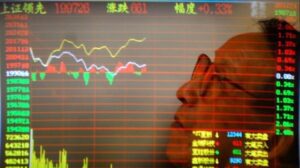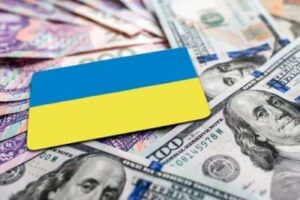
Stock indices of the countries of the Asia-Pacific region (APR) started trading on Monday with growth.
The Hong Kong Hang Seng rose 1.4% by 8:20 am KSK, while the Chinese Shanghai Composite added 0.1%.
The leaders of the rise in quotations on the Hong Kong Stock Exchange are shares of BYD Co. Ltd. (+7.5%). The country’s leading new energy vehicle (NEV) maker posted a record third-quarter net profit due to a surge in sales in China.
The shares of the IT company Tencent Holdings Ltd are also actively rising. (+6.8%) and casino operator Sands China Ltd. (+6.3%).
Railway Papers China Railway Group Ltd. cheaper by 6.8%. The company posted a 4.5% increase in net income last quarter, but an adjusted figure excluding government subsidies and interest income fell 2.5%.
Stock quotes of the developer Longfor Group Holdings Ltd. fell by almost 21% on the news of the resignation of the chairman of the board of directors of the company, Wu Yajun.
The cost of securities of another developer China Vanke Co. fell by 6.2% after the publication of financial statements. The company’s net profit in July-September fell by 14%.
Shares of automaker Geely Automobile Holdings Ltd. rise in price by 1.8%. The company plans to spin off its electric vehicle division into a separate business and list its shares on the stock exchange.
The Purchasing Managers’ Index (PMI) in China’s manufacturing industry fell in October to the lowest since July 49.2 points from 50.1 points a month earlier, according to the State Bureau of Statistics of China (GSO). On average, experts expected it to drop to 50 points, Trading Economics notes.
An index value below 50 points indicates a decline in activity in the sector. PMI is a leading indicator of business activity as managers make purchases based on expected demand.
The Japanese Nikkei 225 rose by 1.6% by 8:30 am KSK.
The shares of electronics manufacturer Alps Alpine Co. have risen most significantly. (+16%), which produces spare parts for industrial equipment JTEKT Corp. (+10%) and equipment manufacturer Keyence Corp. (+8.4%).
Among the leaders of growth in the composition of the Japanese indicator, securities of Toyota Tsusho Corp. are also traded. (+8.3%) after the publication of financial statements. The company increased its net profit by 19% in the third quarter and improved its forecast for the year.
Retail sales in Japan in September increased by the most since May 2021 – by 4.5% compared to the same month last year, data from the country’s Ministry of Economy, Trade and Industry showed. Analysts, on average, expected a less significant increase of 4.1%, according to Trading Economics.
Industrial production in Japan in September fell by 1.6% compared to the previous month, according to preliminary data. The index recorded a decline for the first time since May. In August, it rose by 3.4%. The consensus forecast assumed a decline in the indicator by 1%.
The South Korean Kospi index rose 1% by 8:40 am KSK.
Quotes of securities of one of the world’s largest manufacturers of chips and electronics Samsung Electronics Co. grow by 4.2%. Shares of automakers Kia Corp. decrease by 0.5%, Hyundai Motor Co. – by 0.3%.
The Australian S&P/ASX 200 rose 1.2%.
The growth leaders were the shares of agro-industrial GrainCorp Ltd. (+7.9%), auto retailer ARB Corp. Ltd. (+7.5%) and medical Nanosonics Ltd. (+7%).
Retail sales in Australia rose 0.6% in September from the same month last year, according to the Australian Bureau of Statistics. The pace of recovery was higher than the consensus forecast of analysts in The Wall Street Journal at 0.4%. The index rose for the ninth month in a row.

Oil prices tumble on Monday on signs of a continued slowdown in economic activity in China due to tight quarantine measures to curb the spread of COVID-19.
The Purchasing Managers’ Index (PMI) for China’s manufacturing industry fell to its lowest level since July of 49.2 in October from 50.1 a month earlier, according to data from China’s National Bureau of Statistics (GSO).
An index value below 50 points indicates a decline in activity in the sector.
PMI services in China in October fell to 48.7 points, dropping below 50 points for the first time since May.
The cost of December futures for Brent oil on the London ICE Futures exchange by 8:15 am TST on Monday is $95.03 per barrel, which is $0.74 (0.77%) lower than the closing price of the previous session. As a result of trading on Friday, these contracts fell by $1.19 (1.2%) to $95.77 per barrel.
December futures expire at the close of the market on Monday. More actively traded January contracts fell by $0.69 (0.74%) to $93.08 per barrel.
The price of futures for WTI oil for December in electronic trading on the New York Mercantile Exchange (NYMEX) has decreased by $0.49 (0.56%) by this time, to $87.41 per barrel. By the close of previous trading, the value of these contracts fell by $1.18 (1.3%) to $87.9 per barrel.
As a result of last week, Brent rose by 2.4% per barrel, WTI – by 3.4%. The market closes the month with a rise of almost 10% due to the decision taken by OPEC + to cut production from November by 2 million barrels per day.
“Oil prices are likely to rise as OPEC+ cuts production and the EU embargo on Russian oil purchases (introduced in response to the continuation of the full-scale war unleashed by the Russian Federation against Ukraine – IF) will come into force on December 5,” notes the managing director Vanir Global Markets in Singapore James Whistler quoted by Bloomberg.

Prices of Ukrainian Eurobonds, which stabilized the week before last after a month-long 20% drop, resumed a slow decline last week, losing an average of 3% and dropping to a level near a historic low.
According to Bloomberg, at the short end, the losses were less than in its middle and at the long end, in particular, 2025 dollar Eurobonds fell in price by only 0.9%, to 21.9% of par, which corresponds to a yield of about 75.8% per annum. .
Eurobonds in dollars maturing in 2026-2030 were quoted at the end of last Friday in the range of 17.9-19.3%, which is on average 0.6 percentage points (pp) lower than a week earlier, and their current rates range from 63.5% to 42.7% per annum.
The price of the longest dollar securities maturing in 2031 and 2034-2035 fell the most – by an average of 4.6%, or 0.8 percentage points. – up to 16.7-16.5% of the face value, which corresponds to a yield of 38-35.4% per annum.
As for eurobonds in euros, bonds maturing in 2028 fell in price by 2.8% over the week, to 17.5% of par, and in 2032, by 4.7%, to 15.8% of par. Given the lower nominal interest rate compared to dollar securities, this corresponded to a yield to maturity of 50.6% in the first case and 34.2% per annum in the second.
At the same time, quotes of GDP-warrants remained at the same level last week – 26.2% of the conditional value.

As a result of an enemy strike on critical infrastructure facilities, part of Kyiv has been de-energized, and there is no water supply in some areas, Mayor Vitaliy Klitschko said.
“As a result of attacks on critical infrastructure, part of the capital has been de-energized. There is no water supply in some areas. All services are working. More details later,” Klitschko wrote on his telegram channel on Monday.

PJSC Interpipe Nizhnedneprovsky Pipe Rolling Plant (Interpipe NTRP, Dnipro) ended January-September of this year with a net loss of UAH 1 billion 933.943 million against a net profit of UAH 141.705 million for the same period last year.
According to the interim report of the company, published on Friday, net income for this period decreased by 14.3% – to UAH 5 billion 248.188 million.
Retained earnings by the end of September 2022 amounted to UAH 1 billion 941.983 million.
As reported, Interpipe NTZ ended 2021 with a net loss of UAH 486.412 million against a net profit for 2020 of UAH 22.905 million. Income for 2021 amounted to UAH 8 billion 225.588 million (for 2020 – UAH 9 billion 470.237 million).
Interpipe NTZ for the nine months of 2021 increased its net profit by 3.6 times compared to the same period last year – up to UAH 141.705 million, net income decreased by 17.3% – up to UAH 6 billion 123.667 million.
Interpipe NTRP produces longitudinally welded pipes with diameters from 152 to 530 mm. Its production capacity exceeds 850 thousand tons.
According to the NDU for the second quarter of 2021, Interpipe Ukraine LLC owns 12.0902% of its shares, KLW Limited (Cyprus) – 60.8197% and Interpipe Limited (Cyprus) – 21.8405%.
The authorized capital of PJSC “Interpipe NTZ” is UAH 100 million, the par value of the share is UAH 0.25.
Interpipe is an international vertically integrated pipe and wheel company, one of the world’s top ten manufacturers of seamless pipes and the third largest manufacturer of solid-rolled railway wheels in the world.
The structure of the company includes five industrial assets: Interpipe Nizhnedneprovsk Pipe Rolling Plant (NTZ), Interpipe Novomoskovsky Pipe Plant (NMTZ), Interpipe Niko-Tube, Dnepropetrovsk Vtormet and the Dneprostal electric steel-smelting complex under the Interpipe Steel brand .
The ultimate owner of Interpipe Limited is Ukrainian businessman Viktor Pinchuk and members of his family.

Negotiations are currently underway with Russia on the status of the “grain deal” after Moscow announced yesterday that it was suspending participation in it, Bloomberg reported on Sunday, citing an unnamed Turkish official.
“Negotiations with Russia on the Black Sea “grain deal” are being held on Sunday, they will continue on Monday, a representative of the Turkish authorities said,” the agency reports.
According to the source of the agency, there are grounds for optimism, despite the current situation.
He also said that ships that have reached Istanbul are being inspected, but no new ships loaded with grain are leaving Ukrainian ports at the moment.